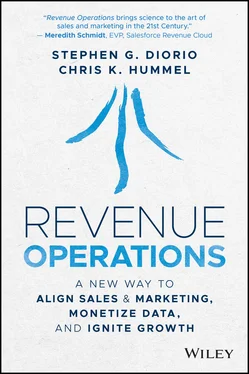Stephen Diorio - Revenue Operations
Здесь есть возможность читать онлайн «Stephen Diorio - Revenue Operations» — ознакомительный отрывок электронной книги совершенно бесплатно, а после прочтения отрывка купить полную версию. В некоторых случаях можно слушать аудио, скачать через торрент в формате fb2 и присутствует краткое содержание. Жанр: unrecognised, на английском языке. Описание произведения, (предисловие) а так же отзывы посетителей доступны на портале библиотеки ЛибКат.
- Название:Revenue Operations
- Автор:
- Жанр:
- Год:неизвестен
- ISBN:нет данных
- Рейтинг книги:3 / 5. Голосов: 1
-
Избранное:Добавить в избранное
- Отзывы:
-
Ваша оценка:
- 60
- 1
- 2
- 3
- 4
- 5
Revenue Operations: краткое содержание, описание и аннотация
Предлагаем к чтению аннотацию, описание, краткое содержание или предисловие (зависит от того, что написал сам автор книги «Revenue Operations»). Если вы не нашли необходимую информацию о книге — напишите в комментариях, мы постараемся отыскать её.
Revenue Operations: A New Way to Align Sales and Marketing, Monetize Data, and Ignite Growth
Revenue Operations
Revenue Operations
Revenue Operations — читать онлайн ознакомительный отрывок
Ниже представлен текст книги, разбитый по страницам. Система сохранения места последней прочитанной страницы, позволяет с удобством читать онлайн бесплатно книгу «Revenue Operations», без необходимости каждый раз заново искать на чём Вы остановились. Поставьте закладку, и сможете в любой момент перейти на страницу, на которой закончили чтение.
Интервал:
Закладка:
This ambiguity and lack of stewardship applies to all the large and valuable growth assets in the business. In particular this applies to large capital investments in the sales and marketing technology portfolio and what we call the owned digital channel infrastructure (websites, digital marketing, mobile apps, and e-commerce). These are displacing paid media in the growth investment mix and have become essential to competitive differentiation in B2B selling.
The Challenges of Growth in the Twenty-First Century: Customers, Disruptions, and Fragmentation
Several factors have changed how we generate revenue growth in the past 30 years. Customer expectations have shifted as buyers have become more digital, better informed, and impatient. Traditional selling processes have been disrupted to become more capital intensive as more buying activity happens within the digital channel infrastructure and as sales personnel rely on analytics and automation to deliver against customers' demands. These challenges are being amplified by the growing appetite of owners, investors, and CEOs to replace episodic sales transactions and fragmented teams with reliable recurring revenues and aligned organizations (see Figure 1.5).
Here are some of the forces and megatrends that have changed the basis for generating revenue growth over the past 30 years:
Changing buyer behavior has elevated the customer experience and made it the primary goal. Business-to-business buying behavior has passed the tipping point where “new school” digital buying behavior becomes pervasive and forces organizations to adapt traditional selling models to meet customer expectations for faster cadence, complete answers, digital channel engagement, and relevant content. It's well known that digitally enabled customers armed with better information are pushing sellers to deliver a superior customer experience in the “moments that matter” across the entire revenue cycle. As buyers become more digital and demanding, those moments will ultimately become the only way to differentiate your business. Customers want more relevant information and complete answers faster. Recent research shows most buyers don't even want to talk to humans if they don't have to. FIGURE 1.5The Megatrends That Changed the Growth FormulaFor decades, research and collaboration, and increasingly transactions have migrated to digital channels. Over 80% of customers now prefer to communicate via text, mobile, and online chat in service interactions according to the Salesforce.com“State of Service” report. 21These changes in buyer behavior were accelerated by the impact that the recent pandemic had on customer engagement – which doubled the percentage of sales that occur in digital channels, according to research by the Duke Fuqua School of Business. 4Changing buyer demographics are also playing a big role in this change. About 10,000 baby boomers turn 65 every day, according to Forbes. 39Millennial buyers, on the other hand, were raised on Google search and digital channels and expect to do all or most of their buying 100% online; 83% of millennial B2B buyers expect e-commerce to keep them more informed about product choices than ever before. 40Most (55%) of millennial B2B customers today would prefer to buy a complex solution without engaging a sales rep at all, according to Gartner. 17And when they do ask questions, they want fast and complete answers. “Today, half of the working population was born after 1977,” says Jaime Punishill, CMO of Lionbridge. “That's important because the only information paradigm they've known is defined by Google – which is fundamentally an ask-response paradigm. They don't want to sort through big menus or wait for answers. They simply want to ask the question using Google, or voice search, or a human if need be.” 33This is forcing sellers to fundamentally shift the way content and websites are organized from a manual classification scheme to more data-driven response management paradigms based on how buyers search and ask questions. To adapt, sales enablement teams are shifting to a response management paradigm that uses AI to track and anticipate the questions customers ask and make it faster to provide a contextual answer by a sales rep, service rep, chatbot, or a voice-activated device.But if the experience is bad, it can be fatal. Almost 60% would stop doing business with a B2B vendor based solely on a mobile experience that's difficult to use. 40This has elevated the customer experience to the primary goal in selling. This primacy of the customer experience puts pressure on managers to better manage the end-to-end commercial process rather than a few parts or stages of it. Managers struggle to coordinate revenue teams, management systems, metrics, and platforms into a more unified customer experience. It puts a premium on systems and procedures and processes that improve speed and agility, as well as personalize customer experience and connect channels.
The speed and cadence of business is faster. The cadence of customer communications has accelerated as conversations have moved from face-to-face to digital channels. There is less time to rest and regroup between calls. Sales velocity has become so fast that revenue teams and the executives who direct them require real-time customer intelligence and selling guidance. The managers and operations professionals we surveyed rated visibility of customers, seller effectiveness, account health, and pipeline health as the four top drivers of the performance of “4D” (distributed, diverse, digital, and dynamic) revenue teams.
Selling has become more capital intensive. The executives we spoke to told us the key to leading a revenue team in the twenty-first century is more about managing selling systems and less about managing salespeople. As selling has become more digital, it has also become more capital intensive. The capital and operating components of the growth investment mix have both changed significantly in the past 30 years. For example, the commercial technology portfolio – or the sales and marketing technology stack – has grown to represent a large component of growth investment mix and sales and marketing operations overhead. Worldwide spending on customer experience (CX) and relationship management (CRM) software grew 15.6% last year as 81% of marketers say they will compete completely on the basis of CX, according to Gartner. 16The Duke CMO Survey reports marketers are now investing more money in Customer Relationship Management than they are in Branding. 4In all, the average enterprise now has invested in over 20 selling tools. 36Smaller cloud-based businesses use over 30 on average to support selling. 26For the first time, as mass media declines in reach and privacy concerns make third-party media more untenable, at most firms more of the operating budget is being spent on “owned” digital channel infrastructure than on “paid” media (digital or otherwise). 161As a by-product, businesses are investing over 10% of their marketing budgets on advanced analytics to find ways to monetize the valuable customer engagement, seller activity, and product telemetry data this digital selling infrastructure creates. These commercial systems need to be managed more like capital equipment than discretionary expenses if they are going to generate real revenue yields. All of this puts pressure on managers to rationalize, streamline, connect, and monetize the growth technology portfolio to generate greater financial returns from these assets and to better enable scalable and predictable growth. “Connecting the dots” across the increasingly complex and expensive technology ecosystems that support revenue has become a basis for competitive advantage.
Selling is more data driven. A revolution in advanced sales analytics and Artificial Intelligence (AI) – fueled by rich new customer engagement, seller activity data, product usage data sources, and increased investment in analytics – is changing the way companies grow and create value. Advances in AI and a growing portfolio of AI-enabled selling tools are making data-driven selling possible. The benefits of this are faster information flow, better allocation of selling resources, and more visibility into pipeline, account, and opportunity potential. Advanced analytics are helping managers improve the performance of every aspect of the go-to-market system. Such tools will be the primary drivers of growth, competitive advantage, and value creation in the next 25 years. These changes amount to a Copernican revolution in selling, where every action and activity is centered around customer data.
Читать дальшеИнтервал:
Закладка:
Похожие книги на «Revenue Operations»
Представляем Вашему вниманию похожие книги на «Revenue Operations» списком для выбора. Мы отобрали схожую по названию и смыслу литературу в надежде предоставить читателям больше вариантов отыскать новые, интересные, ещё непрочитанные произведения.
Обсуждение, отзывы о книге «Revenue Operations» и просто собственные мнения читателей. Оставьте ваши комментарии, напишите, что Вы думаете о произведении, его смысле или главных героях. Укажите что конкретно понравилось, а что нет, и почему Вы так считаете.











